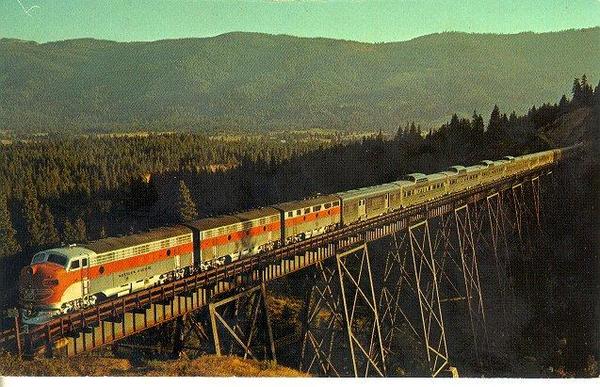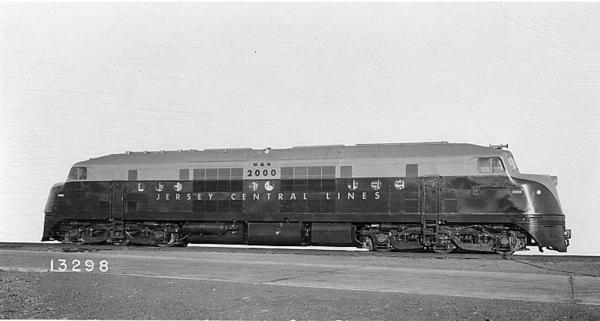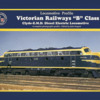IMO, railroads are done with trying to capture the heats and minds of Americans or we would have seen something different over the last 50 years 
I don't know about that. I still go into heat when I see trains.
One thing railroads are trying to do is capture the hearts and minds of shareholders, and efficient locomotive designs are part of that.
The efficiency and money wasn't a goal then too? The F's made no money? The efficiency or safety dangerously compromised.
I go into heat thinking about the loss of public appeal made more obvious, each time a newer member posts about "where's the alternate style".
--"Flame on!"--
(they seem to like the new well enough, but also see "the gap" and also wonder why not?  )
)
The new locomotives are awesome as far as machines go no doubt. Maybe respect wasn't the right word, but a better one escapes me.
The dollar- Mr. Buffet likes long term stable investment, and seems seems to like the RR's quite a bit. A little sheet metal, or fiberglass work on something, on more than the rare occasion? I doubt it's going to break the bank to lighten the dull industrial mood of a styling that Tom, Dick and Nancy can't even see a difference in. It's overdue. I don't care if its sort of limited; some (not all, lol) dog and kitty/ Darth Vader / Spiderman or Johnny Torch comic book B.S. painted by high schoolers, just do something stimulating for the public for a while. I can't tell what I'm looking at half the time. And I live by the tracks, and still like trains enough to rail fan some. But I lost interest in ID-ing anything but a waving engineer, the walkways path, or a logo on passing locomotive. The rest at the head end, I stopped noticing long ago. (personally, the loss of cabooses really hurts way more. That's what I waited for most. But that cost cutter, I really understand more too. The locomotive can't really be dropped without tech making it obsolete 1st, I think we are safe enough there for a bit)
The RR's also need the public good will to retain a grip on other costs too. Much like a restoration, styling is goodwill branding. When times are bad, work on image. When times are good, work even harder on image. Every commercial art and advertising class begins with that thought. (Tell McDonald's, or Apple, or others they are wrong. AD MAN got an opinion that counters that?) The person that doesn't think about trains at all, except for accidents in the news, may be calling JB Hunt, in haste, simply because they saw another bright orange and chrome trim Kenworth on the way to work. Why else would the efficiency of RR's be so regularly ignored, other that its not on folks minds enough? (including many that do logistics for a living)
Evo*, Acela, and some others should have been mentioned as a style counter point. Nicer, IMO, just maybe a little too much "fishbowl/toaster/bomberstyle" (comment in another post) Personal opinion, but maybe it wasn't too far off? I thought I was being a bit picky there, but had a point to push so did. I don't see great style, but it's good, and better than I'm used to. But the best since 1976 had nearly caused a pigment shortage of red, white, and blue, isn't saying much much for style effort.
I'm not saying build carbodies again. Better style could be a simple "cover up panel", roof contour etc.. Or even just better paint, cleanliness, or lighting* Now that's "out the box" EVOlutionary thinkin' a new GENeration will have glowing memories of . If they ever get to see one, even on occasion
. If they ever get to see one, even on occasion  . Nationally, we might not ever see a train that could really use some streamlining again. (which should be a very limiting factor in that styles design anyhow, needing a certain shape vs the slower loco than can have fiberglass bunny ears mounted, and see no big loss or gain, legs can be painted on to match?...(
. Nationally, we might not ever see a train that could really use some streamlining again. (which should be a very limiting factor in that styles design anyhow, needing a certain shape vs the slower loco than can have fiberglass bunny ears mounted, and see no big loss or gain, legs can be painted on to match?...( I just described a copy of the vintage tin 3rail Easter Bunny engine, hopping across the plains
I just described a copy of the vintage tin 3rail Easter Bunny engine, hopping across the plains  A Santa sled? ET on a bike? A Model T? A ship? Trolley? A STEAM engine! ...a bone
A Santa sled? ET on a bike? A Model T? A ship? Trolley? A STEAM engine! ...a bone  Ok, ones not enough, so a box of milk bones since we are talking covers and add ons with no real "meat" and need enough to to be seen in places vs 1 on a screen).
Ok, ones not enough, so a box of milk bones since we are talking covers and add ons with no real "meat" and need enough to to be seen in places vs 1 on a screen).
If all the model trains today got melted for the scrap, and the only replacement was new stuff; I wouldn't switch hobbies to RC planes. I would be buying trains by road name, and paint job, and/or by power source (electrics over diesel, small diesel vs large(? my thing) I will still need a diesel for times and places the juice goes out too.
--"Flame off"--
Just an opinion, but a passionate one.



























